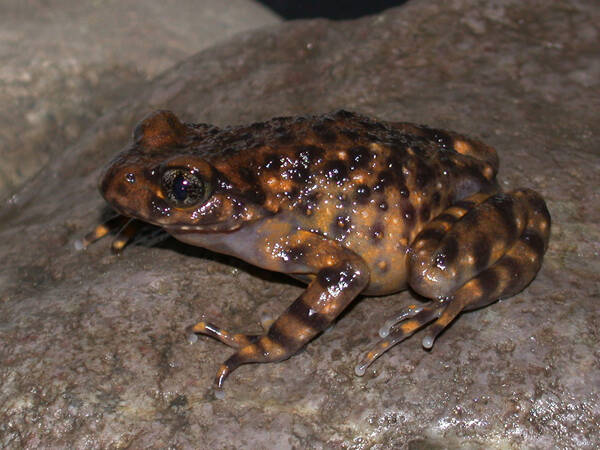Torrentophryne aspiniaYang et Rao
IUCN
LCBasic Information
Scientific classification
- name:Torrentophryne aspiniaYang et Rao
- Scientific Name:Torrentophryne aspiniaYang et Rao
- Outline:Anura
- Family:Anura T.family T.genus
Vital signs
- length:65-103mm
- Weight:
- lifetime:
Feature
The dorsal and ventral warts of adults have no spines or keratin granules on the top; the head, body and dorsal sides of the limbs are gray-brown or light brown-yellow, with no dark spots.
Distribution and Habitat
Endemic to China, distributed in the Yunling Mountains of Yunnan (Yangbi) County.
Lives in mountain streams and their banks at an altitude of 1800-2100m.
Appearance
There is no eardrum or columella; the parotid gland is kidney-shaped, about twice as long as it is wide; there are no teeth in the upper jaw, and no vomerine teeth. The back of the head is relatively smooth, with few warts, and there are many round warts on the sides of the body and the back of the limbs; the ventral surface is densely covered with small flat warts; there are no thorns on the top of the warts on all parts. The back of the head and limbs is gray-brown or light brown-yellow, without dark spots, and there is often a vertical gray-white fine line on the dorsal spine. The ventral surface is gray-white with irregular black lines.
Details
This toad lives in mountainous areas at an altitude of 1800-2100m, often living in streams and their sides. The environment is an agricultural area, where crops such as corn, peas or buckwheat are planted; the woodlands are mostly walnuts, pine forests and broad-leaved trees.

There is a cluster breeding behavior, and male toads have a strong competition for females in courtship behavior. The male toad holds the female toad's chest with its forelimbs, and the pairing behavior lasts about 2-4 days. The eggs are laid in the backwater pond with slow water flow, and the eggs are in the tubular gelatinous belt. Eggs can be laid during the day or night, and the egg-laying process takes about 3-6 hours. A female toad lays 1500-3000 eggs at one time. The eggs and tadpoles develop and grow in the stream water, and the tadpoles complete metamorphosis and land on the shore before the rainy season of the following year.
Breeding season: October, November
Endemic to China. The distribution area of this toad is narrow and its population is small. Threat level: Vulnerable VU.
Listed in the second level of the "List of National Key Protected Wildlife in China"








